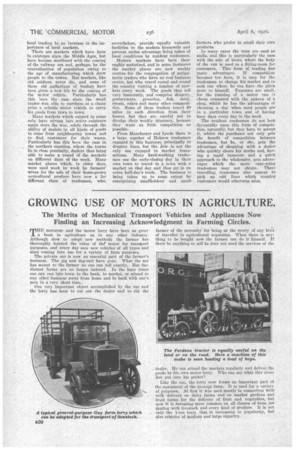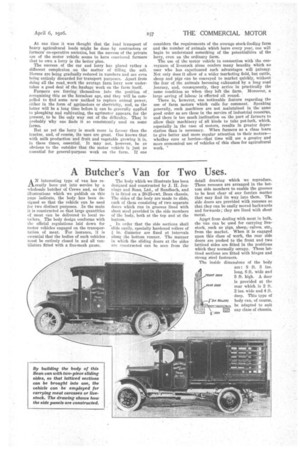GROWING USE OF MOTORS IN AGRICULTURE.
Page 14

Page 15

If you've noticed an error in this article please click here to report it so we can fix it.
The Merits of Mechanical Transport Vehicles and Appliances Now Finding an Increasing Acknowledgment in Farming Circles.
THE motorcar and the motor lorry have been as great a boon in agriculture as in any other industry. Although slow to adopt new 'methods the farmer has thoroughly learned the value of the motor for transport purposes, and every day sees new vehicles of all types and sizes coming into use for a variety of farm purposes.
The private car is now an essential part of the farmer's business. The gig and dog-cart have gone. What the ear has meant to the farmer -no one can tell exactly. But fardistant farms are no longer isolated. In the busy times one can run into town to the bank, to market, or attend to any other business away from home and be back with one's men in a very short time.
One very important object accomplished by the car and the lorry has been to cut out the dealer and to rid the farmer of the necessity for being at the mercy of any kind of traveller in agricultural requisites. When there is anything to be bought now the farmer can do it himself, if there be anything to sell he does not need the services of the dealer. He can attend the markets regularly and deliver the goods by his own-motor lorry. Who can say what this alone has put into his pocket?
Like the ear, the lorry now forms an important part of the, equipment of the liverage farm. It is used for a variety of purposes. At first it was used mostly in connection with milk delivery on dairy farms and Oil market gardens and fruit farms for the delivery of fruit and vegetables, but now it is becoming more common on all classes of farm for dealing with livestock and every kind of produce. It is not only the 1-ton lorry that. is increasing in popularity, but also vehicles of medium and large Capacity.
At one time it was thought that the road transport of heavy agricultural loads might be done by contractors or farmers co-operative societies, but the success of the private use of the motor vehicle seems to have convinced farmers that to own a lorry is the better plan.
The success of the car and lorry has placed rather a different complexion on the matter of tilling the soil. Horses are being gradually reduced in numbers and are even being entirely discarded for transport purposes. Apart from doing all the road work the average farm lorry now undertakes a good deal of the haulage work on the farm itself.
Farmers are forcing themselves into the position of , recognizing this as the herselese age, and they will be compelled to find some new method to replace animal power, either in the form of agrimotors or electricity, and, as the latter will be a long time before it can be generally applied to ploughing and cultivating, the agrimotor appears, for the present, to be the only way out of the difficulty. That is probably why one finds it so consistently used on some farms.
But as yet the lorry is much more iu favour than the tractor, and, of course, its rises are great. One knows that with milk production and fruit and vegetable growing it is, in these times, essential. It may not, however, be so obvious to the outsider that the motor vehicle is just as essential for general-purpose work on the farm. If one considers the requirements of the average stock-feeding farm and tbe number of animals which leave every year, one will begin to understand something of the potentialities of the lorry, even on the ordinary farm.
The use Of the motor vehicle in connection with the Conveyance of livestock alone confers many benefits Which no user who has experienced such advantages will gainsay. Not only does it allow of a wider Marketing field, but cattle, sheep and pigs can be conveyed to market quickly, without the fear of the animals becoming exhausted by a long road journey, and, consequently, they arrive in practically the same condition as when they left the farm. Moreover, a large saving of laboue is effected all round. "
There is, however, one noticeable feature regarding the use of farm motors which calls for comment. Speaking generally, such machines are not maintained in thee same good order as are those in the service of industrial concerns, and there is too much inclination on the part of farmers to allow their machinery of all kinds to take pot-luck, which, especially in the case of motors, results in greater depree elation than is necessary. When farmers as a class learn to give better and more regular attention to their motors— whether cars or lorries—that time will see a „greater and more economical use of vehicles of this class for agricultural work. *
































